Social media verification is one of the most sought-after icons on the web. Just about anything else you can obtain through a little bit of tenacity or a bit of trickery. Security badges? Easy. Restricted accounts? Might cost a bit, but they’re not in short supply. Verification, though, requires overview from the social network involved, and often requires jumping through hoops to get. That’s if you can get it at all.
The problem with social media verification in my mind is that it doesn’t do a lot for you.Yes, it makes your profile the official profile for your brand, but how much good is that really worth?
One of the biggest problems with verification is that in order to be under consideration for verification, you typically need to be a very popular account with a lot of followers. I’m talking in the hundreds of thousands here, not “I’ve amassed 10,000 followers” large. By the time you have that any followers, the perks of verification are minimal. An impersonator account is going to be pretty obvious, since it will have half a percent of the number of followers you have. People won’t have a hard time identifying which is the real account. It’s just not that useful.
In any case, let’s take a look at Instagram specifically and what they have to say about verification. Maybe it’s an easier process than normal, or maybe it’s more valuable than Facebook or Twitter verification.
What Instagram Says
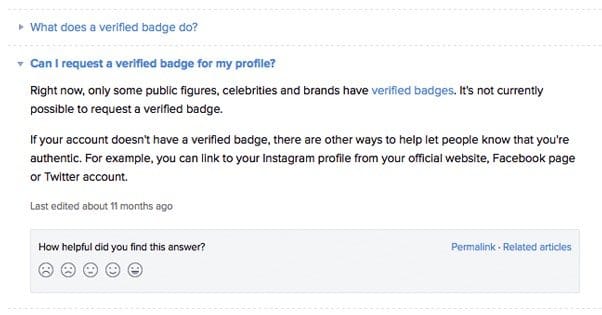
Instagram has a basic help page that is more or less taken wholesale from the Facebook version, which doesn’t bode well for its value. Here’s what it says specifically.
What is a verified badge on Instagram? It’s a little checkmark, blue as it is on almost every network, next to the user’s name in search and in their profile. The only accounts that can be verified are those representing well known public figures, celebrities, and “global brands” on Instagram. Verification is given to these accounts to combat the high likelihood of impersonation, which Instagram doesn’t like or want to deal with if at all possible. Of course, they do have a process in place for reporting impersonation.
What does a verified Instagram badge do? All it does for this network is make it easier to identify you as being you, rather than someone who shares your name or who is impersonating you. It’s just an icon, and carries no special powers, access, or security. Verification won’t make it any harder to hack or access your account, nor does it give you access to any special tools like Pinterest’s does.
Can you request verification? According to Instagram’s help page, no. “Right now, only some public figures, celebrities and brands have verified badges. It’s not currently possible to request a verified badge.” Instead, Instagram recommends that you provide other forms of social proof of your identity, like linking your other social accounts.
Some people also wonder, if they have a verified account on Facebook and Facebook owns Instagram, why don’t they have a verified account on Instagram? The answer is because they’re different systems on different sites. Maybe if they had a unified login you would be able to do that, but there’s no such unified system in place.
That said, verification on Facebook and Twitter can be helpful. You can link from those pages to your official Instagram, which lends it credibility. An impersonator can’t do that, so the verification does give you an additional bit of, well, verification. One thing it won’t do, however, is make it any easier to verify an Instagram profile.
Verification on Instagram is relatively new. It was only launched in December of 2014, so it’s still under a year old. Consider it more of a pilot program than a public access program right now, and you’ll have the right attitude. It’s just not possible to do a specific set of steps to achieve verification.
That said, you can certainly do things to make it more likely that you will be verified the next time they go through and verify accounts.
Instagram Verification Issues
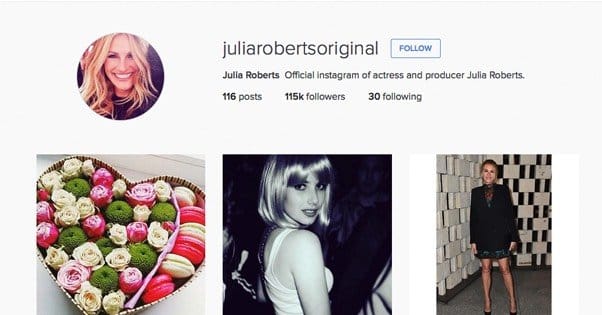
Back in February, Instagram ran into some trouble with verifying accounts. Namely, they ran into “serious legal problems” with their verification process. At the time, they paused their verification efforts until the process was refined and the trouble went away.
No one is quite sure what the verification process involved or why it was causing trouble. My speculation – and this is all it is, speculation – is that celebrities didn’t like being asked to submit legal documentation of their identities, not even to a business as concerned with security as Facebook.
The post I just linked reported that four accounts specifically – all actresses – had not yet received verification. Of these four, two of them have since received verification. Why is that? Who knows. They’re all big name actresses with active accounts, so it seems like they should all be verified. I don’t have insight into the process or the requirements beyond what I know about verification in general.
So, what can you do to increase the chances of verification, if and when Instagram chooses to look your way?
1. Amass a Huge Following
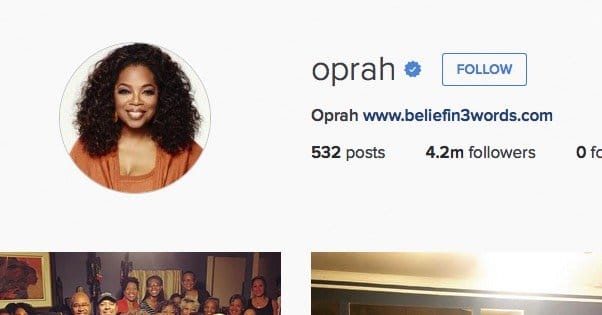
The first and most obvious means to getting verified on any social network is to be exceedingly popular. I’ve talked before about the number of people required to be verified, and it changes dramatically from platform to platform. I’ve seen verified Facebook accounts with as few as 1,000 followers, and I’ve seen unverified brand pages with over 1 million. It’s really hit or miss and seems to depend on how the admins feel that day.
The thing is, you really can’t go wrong by getting more followers. I’m not even saying that as a representative of a service that sells them; it’s just true. You need more followers so you can make better use of the site in general, both organically and with your marketing.
In addition to being useful for marketing, a higher follower count puts you higher in search results and makes you easier to differentiate from people who might try to impersonate you, either maliciously or as a troll.
How can you get more followers? I’ve included some basic tips here, but you can read a more detailed article over on Forbes.
- Stick to a theme, voice, and personality. For many celebrities this is easy, but brands often try a shotgun approach to see what works. This is fine early, but as you go and grow, you will need to refine your posts to stick with a theme.
- Post on a schedule. Like any social network, the more active you are, the more chances people have to engage with your account and the more you’ll grow.
- Use hashtags properly. This includes using the occasional branded tag, but also mean you should use uncommon hashtags. Using overly common hashtags isn’t going to get you more exposure, it’s going to get you lost in the flood of content in that tag.
- Engage. Social networks are social, and that means you need to be social back. You can’t treat Instagram like an image hosting site, you need to treat each picture as an opening to a conversation.
- Post good content. Instagram is very heavily image-focused, which means you absolutely need good quality images. You can’t just slap something together in a meme generator and hope it works. I’m talking professional photographers and real image editing software here.
- Follow all of the image composition tips put forth in this article. It’s all under tip number 10, and includes tips like using the “correct” colors and not using filters.
2. Represent a Celebrity
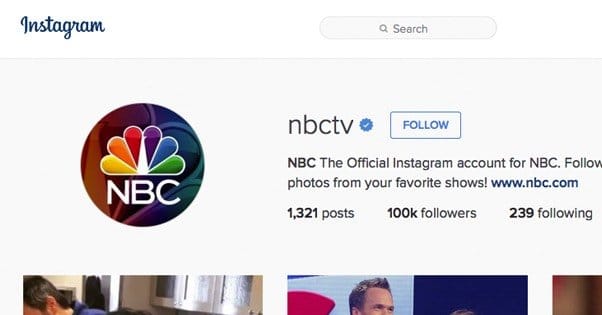
Unfortunately, this tip isn’t very useful. Instagram is much like Facebook in terms of verification, which makes sense since it’s the same company behind the scenes. That means the people who can be verified are very limited. A lot of brands, even large domestic brands, aren’t able to get verification because of their focus or their industry. The only accounts that can be successfully verified on Instagram are those for public figures like politicians, CEOs, sports stars, celebrities and prolific journalists. Additionally, accounts for global brands like NBC or the BBC or ESPN could be verified, though it’s almost entirely on the backs of “if we don’t verify these people it will be bad for us.”
I don’t recommend changing your business just to get Instagram verification. It’s not valuable enough to be worth it. I’m just putting this “tip” here to let you know that if you’re a small business, a band, a shop, an online retailer or really anything other than a high profile celebrity, you’re going to have a hard time getting verified.
That said, it’s always possible that Instagram will broaden their requirements in the future and will include any entity that can be harmed by impersonation. A small business is certainly more vulnerable than a celebrity when it comes to malicious impersonation, so it stands to reason that they might do this. You know, once the kinks in the process are worked out.
3. Be Impersonated
Okay, so this isn’t really an actionable tip either. It’s logical, though. Verification is a mechanism that exists solely – according to Instagram – to be a layer of security for people who are impersonated. It’s there so users can tell between two accounts with the same name and profile picture, identifying which one is the real one.
Therefore, it stands to reason that the most surefire way to receive verification is to have someone impersonate you. The problem is, this isn’t really a sure thing. Yes, verification is a preventative measure against the damage that can be caused by an impersonator. However, it’s not the process for solving the issue of impersonators. There’s a process, a form, that you have to go through to prove you are who you say you are and that the impersonator is negatively affecting your business.
When that happens, you don’t receive verification. You just get to keep your account while the impersonator is removed or forced to change. The only benefit you get out of the process is removing the confusion your users might feel when seeing two identical accounts and not knowing which one is yours.
While you won’t get verification out of the deal, I do think it’s quote unquote “beneficial” to be impersonated once, for verification purposes. I figure it probably puts you on a shortlist such that, if you meet the criteria, you will be verified in the next wave. That said, it’s entirely speculation on my part and there’s no actual factual basis for that speculation. So, you know, don’t go out and create an impersonator of yourself, you might end up IP banned, and then were will you be?
4. Stay Active
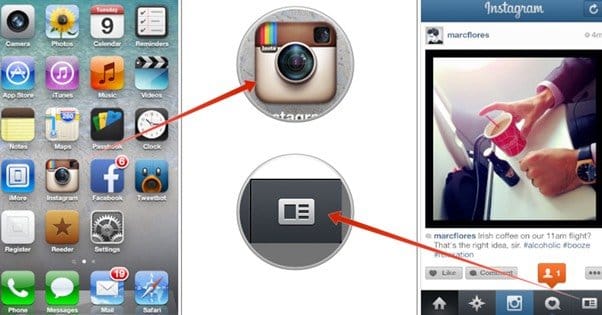 You’ll never be verified if you don’t use the platform. If Instagram admins were to come by looking to see if you’re worth verification, and they see you haven’t posted in a month, they’re going to pass you over. They don’t care if you’ve been impersonated before. They don’t care how active you used to be. They especially don’t care how much you want verification. If you’re not actively using the platform, there’s no reason for them to bother initiating the process for you.
You’ll never be verified if you don’t use the platform. If Instagram admins were to come by looking to see if you’re worth verification, and they see you haven’t posted in a month, they’re going to pass you over. They don’t care if you’ve been impersonated before. They don’t care how active you used to be. They especially don’t care how much you want verification. If you’re not actively using the platform, there’s no reason for them to bother initiating the process for you.
It goes the other way too. Why would you want verification if you aren’t actively using the platform? It does nothing for you just to have it. There’s no reason to get verified if you’re not using the site, full stop.
5. Avoid Negative Actions
This one is a little more nebulous, and I have no way of knowing if it’s actually a factor, but here goes. I recommend that you avoid buying fake followers, both in general and for this purpose.
For one thing, Instagram doesn’t like it. They have been known to purge fake fans, and the results have been devastating for many high profile users. Of course, most of these users were already candidates for verification and may have been verified already. In fact, I would venture to guess that the purge was targeting users they wanted to verify. Something like an audit; if you want verification, we’re going to make sure your audience is actually as large as you say it is.
As far as I know, no one was de-verified in the purge. Then again, verification had only existed for a week when the last great purge happened.
Fake followers, of course, also hurt your ability to succeed on the platform. They make you look worse. If two different accounts each have a million followers, and one of them gets 10x the engagement of the other, the one with lower engagement has something up with their audience. Fake followers often account for that.
All that said, I’m sure you’re leaving this post with a bit of a sour expression. I boast give steps to getting verified, and then give you nothing of use. The reason for that is just that there’s no process. There’s no way to actually request or ask for verification, you just have to hope Instagram notices you and decides to offer it to you and grow a large audience to increase your chances. The best you can do is grow and get noticed.
2018 Update
Getting your Instagram account verified is now much simpler if you have a Facebook page that is already verified. Facebook is rumored to be easy to achieve verification than Facebook, making it a good place to start if you’re having trouble achieving verification on Instagram. The two are tightly linked together, as they are both owned by Facebook. Most verification services that charge for this require that you have a verified Facebook page before attempting Instagram verification for this very reason. Be warned, though, most of these services will steal your money, and the best way to achieve verification is always to grow your pages and to do it yourself.

